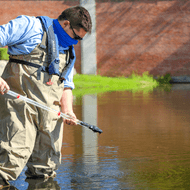
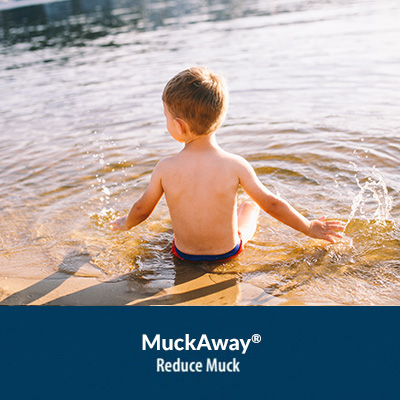
MuckAway Pellets Study

The Challenge: Located in Rochester Hills, Michigan, two ponds were chosen due to a long history of organic growth and heavy pond muck. Both ponds measured 0.75 acres, 10' deep, and were eutrophic, stagnant environments used primarily for stormwater retention.
The Solution: MuckAway Pellets were applied per labeled directions to one of the 0.75-acre ponds over 16 weeks. The other 0.75-acre pond was left as a control. Average muck depths were recorded using systematic sampling within 16 area frames every month. Samples were submitted to an independent laboratory for analysis.
The Results: At the end of 16 weeks, the treated pond showed greater than a 28% reduction in sediment depth. Laboratory analysis also revealed a significant reduction in Percent Organic Content, over a 25% difference between the treated and control pond. The control pond continued accumulating additional sediment depth, nearly 8%, during the study period.
Muck Reduction Study - Using MuckAwayPellets
Application: Subdivision Ponds, Rochester Hills, Michigan
Airmax MuckAway
Abstract:
Trevor Henderson, Airmax Aquatic Biologist
Retention ponds in southeast Michigan are typically characterized by warm, nutrient-rich shallow waters. A Homeowners Association (HOA) in Rochester Hills became frustrated with the algae-laden condition of their two neighborhood retention ponds, and they sought Airmax to resolve the issues. The HOA wanted to reduce the muck levels, stifling their fountains, and increase the fishing opportunities for their homeowners. Beginning in June 2020, MuckAway Pellets were applied biweekly throughout the summer. A Sludge Judge was deployed to read the levels of muck monthly. After one summer of treatment, the muck was reduced by nearly 30%.
Introduction:
The Clinton Watershed in southeast Michigan is one of the most developed areas in the state, home to over 1.4 million people. This urban environment is also one of the lowest elevations in the state, featuring over 1,000 miles of streams and rivers transporting nutrients to the Great Lakes. Before making it to the Great Lakes, the water travels through several thousand ponds and lakes. The area's ponds and lakes have very high nutrient levels, ranking them as "hypereutrophic," They suffer from severe algae blooms, low transparency, and excessive muck levels.
In late 2019 a Rochester Hills, Michigan, HOA became frustrated with the condition of their two neighborhood retention ponds of 0.72 and 0.76 acres and sought Airmax for a solution. Airmax developed a Best Management Plan (BMP) consisting of a biweekly application of MuckAway.
MuckAway Pellets are designed to sink into the muck layer and release aerobic bacteria, enzymes, and biostimulants, which speed up bioaugmentation and increase the digestion of organic sediments. The result is a reduced nutrient load. Reducing internal nutrient loading through the reduction of organic muck improves the overall state of the waterbody.
Methods:
MuckAway Pellets were applied by a boat-mounted granular spreader to one pond a total of eight times during 16 weeks, following the recommended rates of application specified on the product label. Muck depths were measured monthly before each MuckAway application, using an area-frame systematic sampling method, as shown in Figure 1.1. To measure muck reduction, a Sludge Judge was used to estimate the depth of muck in each of the 16 quadrants. Soft-sediment depths were measured three times per section, and the average was recorded.
In addition to the data collection listed above, an independent laboratory examined an initial and final representative sample of the sediment, testing for Sediment Organic Content and Average Particle Size. This independent study analyzed the content of the sediment, revealing a reduction in organics and evidence that larger organics were being broken down into smaller particles.
The complete process was repeated in the second pond in the HOA but without bacterial treatments, to be used as the control pond.
Figure 1.1
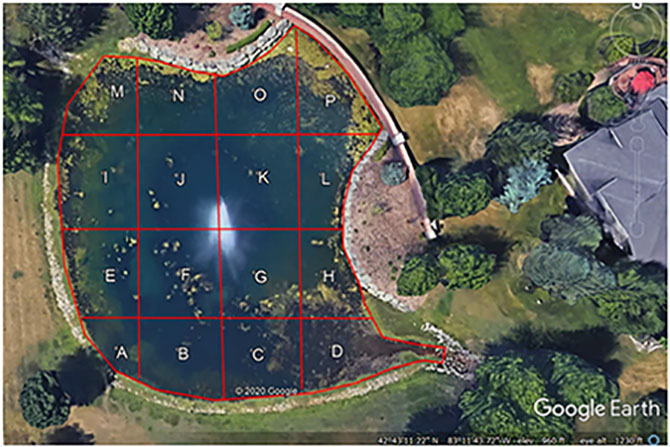
Results:
Average Depth Reductions as a Percent were as follows:

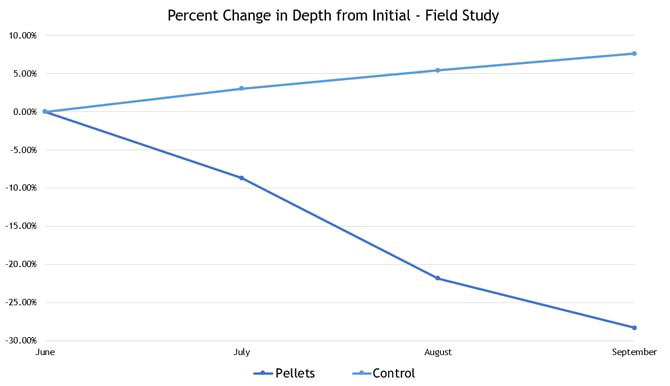
Additional results from independent laboratory included: Sediment Organic Content and Average Particle Size from the field study ponds.
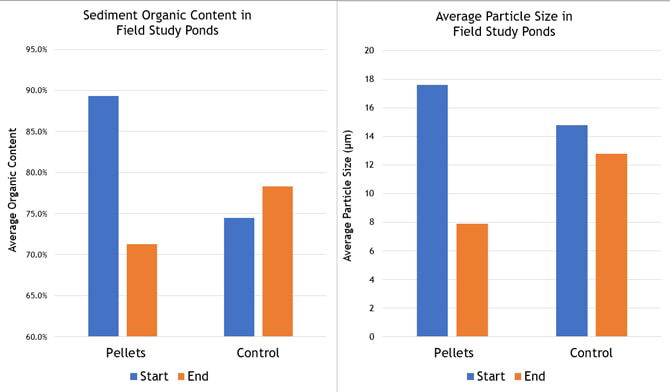
Discussion:
The application of MuckAway yielded a significant reduction in sediment depth in the treated pond over the course of the summer, while the control pond saw an increase in sediment depth. The increase in sediment depth in the control pond is to be expected, as the waterbody was heavily loaded with nutrients. The nutrient load only increased over the summer as algae blooms, landscaping organics, and stormwater washout debris accumulated more rapidly than the native bacterial populations could break it down.
While these same environmental factors were affecting the treated pond, the bacterial additions from the pellets introduced large amounts of faster-acting aerobic bacteria, giving a boost to the populations in the sediment.
Independent laboratory testing measured particle size and organic content of the sediment in both the control and the treated ponds. With MuckAway treatment, organic content dropped nearly 21% by mass and the average particle size of the remaining organics was reduced by nearly 56%.
Conclusion:
At the end of the field study, the treated pond showed significantly fewer algae blooms and more areas of sandy sediment. Overall, the treated pond showed improvements in aesthetics and fishing access. While it will still take time to undo the years of organic accumulation, the HOA has agreed to move forward with full bacterial augmentation on both ponds.
In summary, it is very probable that the Best Management Plan that was begun on the pond by Airmax Inc. at the beginning of the season was the cause of the significant differences between the two ponds. Further testing could include more ponds, different variables for testing, and further analysis of the bacterial population compositions. Further sampling would be required to eliminate variation by seasonal factors. Future seasons should see similar reductions in nutrients and improvements in muck depths.
Application: Pellet
Active Temp: Above 50°F
Shelf Life: 5-Years
Restrictions: MuckAway may be applied to lakes and ponds used for irrigation and aquaculture. Water treated with MuckAway may be used for recreation, fishing and other activities immediately after treatment. Safe for recreational ponds, horses, livestock, birds, pets, fish, wildlife, and the environment. Do not apply to water that will be used for human consumption.
